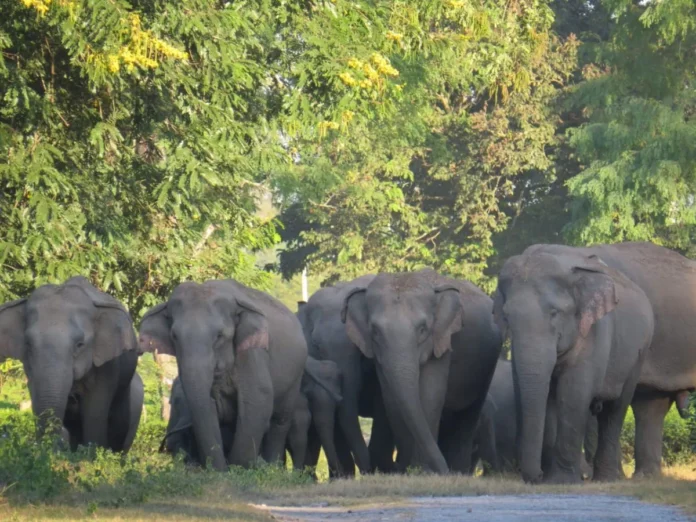In Samaguri, a town in Assam, residents are dealing with an increasing problem that has caused both fear and frustration: wild elephants roaming into populated areas and damaging local properties. Nearly every night, three to four elephants venture into the town, wreaking havoc as they search for food. The situation has put residents on edge, as these unexpected visitors have begun causing substantial property damage and raising serious concerns about safety.
The elephants, likely driven from their natural habitats due to deforestation and habitat fragmentation, seem to be searching for sustenance. Assam, home to nearly 6,000 wild elephants, has always had a close connection with these animals. However, the incidents in Samaguri highlight a growing problem of human-elephant conflict in the region. As forests shrink and food sources become scarce, elephants find themselves wandering into towns and villages where they can easily access food. Unfortunately, this usually results in the destruction of crops, homes, and other structures.
Local farmers are perhaps the hardest hit by these nightly visits. Residents report that elephants have trampled through fields, uprooted crops, and destroyed storage areas where harvested grains were kept. Farmers who have already faced economic hardships find themselves unable to cope with these losses. One resident, a farmer named Dipak Bora, expressed his anguish, noting that his entire year’s harvest had been wiped out in a single night by a group of elephants. For him and many others, these encounters are devastating, impacting their livelihood and their ability to sustain their families.
While property damage remains a significant concern, safety is paramount. Many villagers are fearful of encountering these massive animals, especially after dark. Reports of elephants charging at homes and occasionally knocking down walls have left people feeling vulnerable. Residents, particularly those with children and elderly family members, feel forced to stay indoors after dusk. Community leader Manik Das explained how people now dread the sound of rustling leaves and snapping branches, aware that it could mean elephants are nearby. This level of fear underscores how deep the problem has become and how desperately the community wants a solution.
To combat this issue, local authorities have stepped in to try and minimize the damage. The Assam Forest Department, responsible for managing human-wildlife conflict in the state, has sent teams to Samaguri to monitor the situation. They’ve used firecrackers, lights, and other deterrents to try to drive the elephants back into the forest. However, these measures have proven to be only temporary fixes, as the elephants often return the following night. Forest officials have explained that without sufficient food sources in the wild, elephants will continue to venture into human settlements. These short-term solutions fail to address the underlying problem, which is habitat loss.
Conservationists argue that addressing human-elephant conflict requires more sustainable, long-term solutions. For instance, reforestation efforts could help restore natural habitats, providing elephants with food sources in the wild. Additionally, the construction of dedicated wildlife corridors, which would allow elephants and other animals to move between forested areas without crossing into human settlements, could significantly reduce encounters. Assam’s chief wildlife warden has emphasized that both the community and the elephants need safe spaces, which can only be achieved through habitat conservation and restoration.
Some residents have suggested that the government offer compensation for the damages caused by elephants, as they struggle to cover their losses. The government of Assam does have a compensation program in place for human-elephant conflict, but villagers feel it falls short of covering the extensive damage caused. Locals argue that the compensation process is slow and bureaucratic, often leaving affected families waiting months for relief. Increased financial support and a streamlined claims process would help alleviate the financial burdens faced by those affected.
Despite the fear and frustration, some residents in Samaguri continue to view the elephants with a sense of respect. They understand that the animals are not to blame and recognize the conflict as a consequence of environmental pressures. This respect for elephants is embedded in Assam’s culture, where the animals are often seen as symbols of strength and wisdom. Villagers like Sita Devi express a hope that a peaceful solution can be found, one that allows humans and elephants to coexist without fear or harm. She describes how her family traditionally respected elephants as part of the forest, and she wants future generations to have a similar understanding of these magnificent creatures.
In the meantime, Samaguri residents are adapting as best they can. Community meetings are held regularly to discuss safety precautions and share information on how to protect homes and crops. Some have even built barriers around their fields, while others gather in groups after dark to keep watch over their properties. It is a challenging time for the people of Samaguri, but there is a sense of resilience and a desire to find a sustainable solution that respects both the community and the elephants that roam nearby.




